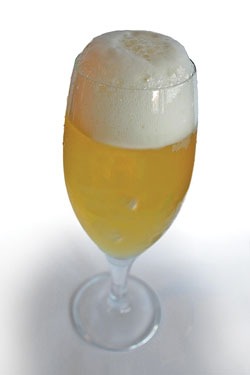Low-Cal Rye Brut IPA
Rye Brut IPA
(5 gallon/19 L, all-grain)
OG = 1.039 FG =1.005
IBU = 20 SRM = 4 ABV = 4.5%
This is out attempt to brew a beer full of flavor but low in calories
Ingredients
7.4 lbs. (3.4 kg) pale malt
1.25 lbs. (0.57 kg) rye malt
6.75 AAU Columbus hops (15 min.) (0.5 oz./14 g at 13.5% alpha acids)
1 oz. (28 g) Kohatu hops (0 min.)
4 oz. (113 g) Nelson Sauvin hops (dry hop)
1 oz. (28 g) grains of paradise (15 min.)
1⁄2 tsp. Glucoamylase (AMG) in fermenter
Omega West Coast Ale I (OYL-004) or SafAle US-05 yeast
3⁄4 cup corn sugar (if priming)
Step by step
Focusing on mash schedule and exogenous enzymes, I endeavored to make a flavorful all-grain beer with an ABV above 4% but that comes in at about 120 calories per 12-ounce (355-mL) serving. As we discussed previously, mash schedule is important in reducing the unfermentable dextrins that add unwanted calories. In my converted cooler mash tun I know I consistently lose 8 °F (4 °C) when I mash in, so to target the 149 °F (65 °C) we mentioned before I mash in at 157 °F (69 °C). It is incredibly useful to have this kind of understanding of your equipment. You can come to learn the ins and outs of your setup over time or you can spend the time to do several trials to fine tune it. After mashing in I let that temperature coast downward. In fact, because I wanted to move the temperature into beta amylase range for this beer, I left the lid off of the mash tun for the first 30 minutes and stirred it three or four times. In those 30 minutes the temperature dropped to 145 °F (63 °C) and I put the lid on, losing just 1 °F (2 °C) over the final 30 minutes of the mash. These steps helped make sure I maximized the fermentable potential in my conversion and minimized dextrin production.
The boil for this beer is very straightforward. Sixty-minute boil, adding spices and hops with 15 minutes remaining in the boil and hops again at flame out. The grains of paradise are a spice I love in lighter beers. It is related to cardamom and comes from West Africa. Grains of paradise bring a sweet and spicy flavor but also have a botanical component. I always get a subtle lavender and juniper when I use this spice.
After cooling to my yeast-pitching temperature and inoculating with yeast, I added glucoamylase. Earlier we mentioned “exogenous enzymes,” these being ones that you are adding to your process as opposed to “endogenous,” which would be the naturally occurring enzymes in your base malts. Glucoamylase will continue to break down any of the remaining dextrin chains into fermentable glucose molecules.
With the mash schedule, and the use of the glucoamylase in the fermenter, I have been able to push the final gravity as low as 1.002 but over my trails with this process I average 1.005. The beer is light with a spicy bite on the tongue and subtle botanical aromas in the nose. With a starting gravity of 1.039 and a final gravity of 1.005 this recipe comes in at around 4.5% ABV and 125 calories, just missing my goal of 120 calories. If desired, I could push the final gravity down a little by swapping some of the grain out and replacing it with 100% fermentable sugar.
Partial mash option: Swap out 6 lbs. (2.7 kg) of the pale malt for 3 lbs. (1.4 kg) of extra light dried malt extract. Mash the crushed grains in a muslin bag in 1 gallon (3. 8L ) water. In a similar fashion as the all-grain version, mash for 60 minutes starting at 149 °F (65 °C) and allowing the temperature to drop to about 145 °F (63 °C) during the first 30 minutes, then maintain that temperature for the duration. Remove the bag and wash grains with 1 gallon (4 L) of hot water. Top up the kettle and add dried malt extract and bring to a boil. Follow the all-grain instructions for boil, fermentation, and packaging.
Written by Johnathan Wilson & Brian Wolf



